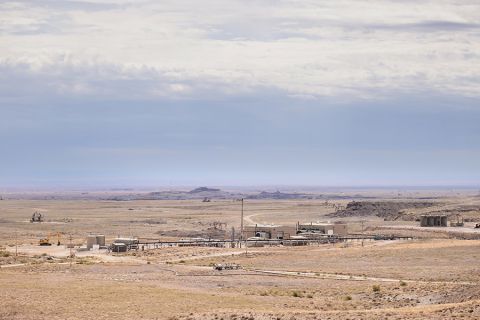
In the past decade the level of water required to hydraulic fracture some wells has skyrocketed. However, not every well is created equal, according to a new study by the U.S. Geological Survey (USGS).
The amount of water it now takes to frack some horizontal wells could fill a 660,000 gallon Olympic-sized swimming pool close to 15 times. Though for some wells, the water used for fracking would fill a children’s inflatable pool only a handful of times.
Water use for fracking depends on where the well is located and what type of well it is, said Tanya Gallegos, a USGS scientist and the study’s lead author.
“One of the most important things we found was that the amount of water used per well varies quite a bit, even within a single oil and gas basin,” Gallegos said.
The USGS researchers found that water volumes for fracking averaged within watersheds across the U.S. range from as little as 2,600 gallons to as much as 9.7 million gallons per well.
For land and resource managers, a better understanding of the volumes of water injected for hydraulic fracturing could be a key to “understanding the potential for some environmental impacts,” she said.
Water use is increasingly of concern in the U.S. California has drastically reduced water use as it faces one of its most severe droughts on record. Across the contiguous U.S., at the end of the four-week period ending June 30, drought covered more than a quarter of the area.
However, in active oil and gas states such as Texas, even elevated water use for drilling isn’t expected to eclipse 1% of all water use, state officials have predicted.
From 2000 to 2014, median annual water volume estimates for fracking horizontal wells had increased to more than 4 million gallons per oil well and 5.1 million gallons per gas well from about 177,000 gallons per oil and gas well, the study said.
During the same period, median water use in vertical and directional wells remained below 671,000 gallons per well.

Horizontal wells generally require more water than vertical or directional wells, though 42% of newly fracked oil and gas wells completed in 2014 were still either vertical or directional.
The universality of the lower water use in vertical and directional wells explains, in part, why the amount of water used per well is varies across the U.S., the study said.
The watersheds where the most water was used to frack wells on average coincided with parts of shale gas reservoirs.
Shale gas reservoirs are often fracked using slick water, a fluid type that requires a lot of water. In contrast, tight oil formations like the Bakken in parts of Montana and North Dakota often use gel-based fracking treatment fluids, which generally contain lower amounts of water, according to the study.
All respondents in a recent Hart Energy Market Intelligence Series report said slickwater fracks are used predominately in the Eagle Ford Shale.
 According to the USGS study, the plays that require the most water include:
According to the USGS study, the plays that require the most water include:
- Eagle Ford;
- Haynesville-Bossier;
- Barnett;
- Fayetteville;
- Woodford;
- Tuscaloosa; and
- Marcellus/Utica.
While three of the top water-demanding plays are in Texas, the major demand in the state is for irrigation, which uses about half of the state’s water. Mining water demand, which includes uses for exploration, development and extraction of oil, gas, coal, aggregates and other materials is expected to represent less than 1% of statewide water uses, according to the Texas Water Development Board. In some locations, particularly around shale, the percentage of water use will be higher.
In 52 out of the 57 watersheds with the highest average water use for fracking, more than 90% of the wells were horizontally drilled, the study said.
The new USGS study was accepted for publication in Water Resources Research, a journal of the American Geophysical Union.
USGS research was carried out as part of a larger effort by the organization to understand the resource requirements and potential environmental impacts of unconventional oil and gas development. Prior publications include historical trends in the use of hydraulic fracturing from 1947-2010, as well as the chemistry of produced waters from hydraulically fractured wells.
Contact the author, Emily Moser, at emoser@hartenergy.com.
Recommended Reading
Water Management Called ‘Massive Headwind’ for Permian Operators
2024-11-21 - Amanda Brock, CEO of Aris Water Solutions, says multiple answers will be needed to solve the growing amounts of produced water generated by fracking.
Chevron Pushing Longer Laterals in Argentina’s Vaca Muerta Shale
2024-09-13 - Chevron Corp., already drilling nearly 2.8-mile laterals at its Loma Campana Field in Argentina, wants to drill even longer horizontals, an executive told Hart Energy.
Now, the Uinta: Drillers are Taking Utah’s Oily Stacked Pay Horizontal, at Last
2024-10-04 - Recently unconstrained by new rail capacity, operators are now putting laterals into the oily, western side of this long-producing basin that comes with little associated gas and little water, making it compete with the Permian Basin.
US Drillers Cut Oil, Gas Rigs for Fourth Week in a Row
2024-09-06 - The oil and gas rig count fell by one to 582 in the week to Sept. 6, the lowest since June.
E&P Highlights: Sept. 23, 2024
2024-09-23 - Here's a roundup of the latest E&P headlines, including Turkey receiving its first floating LNG platform and a partnership between SLB and Aramco.
Comments
Add new comment
This conversation is moderated according to Hart Energy community rules. Please read the rules before joining the discussion. If you’re experiencing any technical problems, please contact our customer care team.




